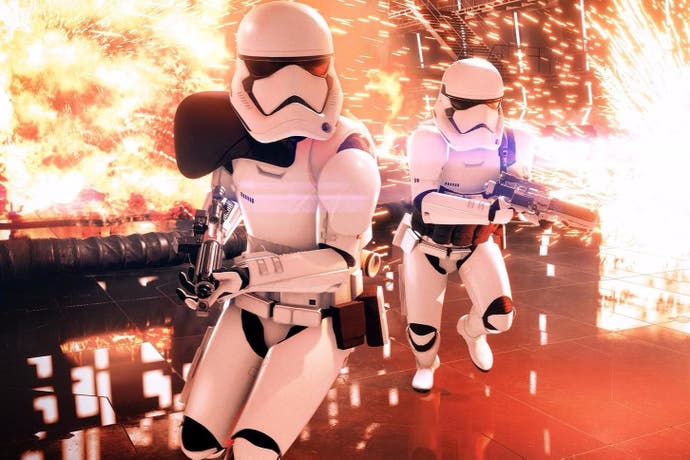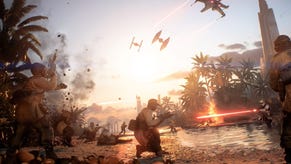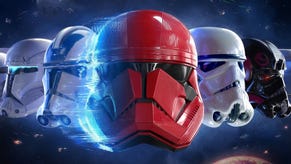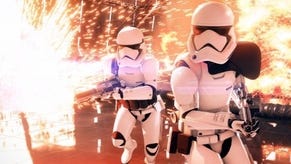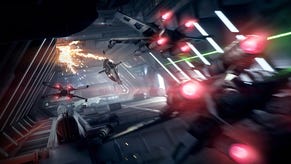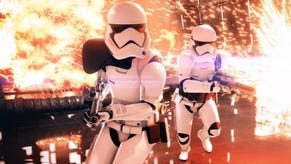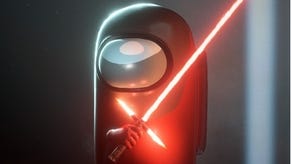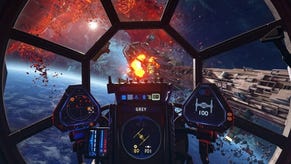Star Wars Battlefront 2 takes Frostbite tech to the next level
Initial analysis from Digital Foundry, plus ultra settings PC video.
Electronic Arts' continuing investment in its talented Frostbite team continues to pay dividends. We played a few rounds of Star Wars Battlefront 2 in the wake of the EA Play event, and initial impressions are very positive - this is an exceptionally beautiful game.
At this point, there's a very strong argument that this might just be the most impressive-looking Frostbite title we've seen - no mean feat bearing in mind that developer DICE is once again targeting that crucial 60fps target frame-rate, while BioWare's Anthem gives us some impression of what this revised technology can do when targeting 30Hz. At the time of writing, we've not seen console code, but our hands-on session was hosted on a high-end PC running Nvidia's GTX 1080 (the non Ti version). Quality settings were locked at default to ultra, meaning that this is peak Battlefront 2, at this point in development at least.
The most striking aspect of the presentation is the lighting and materials, where we may well be looking at a revamp of DICE's superb physically-based rendering system - a key component in the Frostbite toolkit that first debuted in the first Battlefront. Our demo playthrough featured a new Naboo-themed map that showcases a rich selection of materials ranging from the stone work of the city streets to reflective marble of the interior. Metalwork on droids and vehicles also looked sensational, and regardless of how you may feel about Star Wars Episode 1, Naboo's architecture and style was a highpoint and DICE's representation is sensational.
But it's the lighting that really sells it. The interior scenes in particular are strikingly realistic with excellent use of light-bounce, filling each scene with natural hues. The way lighting spills from the bright outdoors into the palace is impressive to behold and showcases the strengths of the engine. Particle lighting is also present and works well, with brightly coloured blaster fire penetrating an illuminating clouds of smoke. And by extension, explosions are remarkably executed too. Battlefront 2 makes heavy use of screen-space reflections in combination with lighting and materials to further enhance each scene. The specular work is, of course, excellent as well.
Another impressive element is the level of detail on display. In comparison to the original DICE title, Battlefront 2 presents a more detailed urban environment with plenty of richly detailed buildings and structures filling the map. When commanding a drone, for instance, you can fly high above the city, creating a great sense of scale only let down by noticeable LOD popping - something that could become even more noticeable on consoles. Curiously, this type of view is reminiscent of Factor 5's Rogue Squadron games on the GameCube but, of course, with a greatly increased level of fidelity.
There are also elements like parallax occlusion maps across many surfaces which helps create detail on a micro-scale and plenty of foliage. Another thing that caught our attention are the particles that swirl around in each level. The debris gently swirls around the environment as you play in a way that really helps create an active scene, even when not engaged in combat. It should be interesting to see how other maps are shaping up in comparison, and what additional, bespoke effects they bring to the table.
As for specifics on the PC version itself, we played the game using a GTX 1080 and we were able to capture at 1440p while maintaining a mostly stable 60fps using the ultra preset - which couldn't be changed in this build. We did attempt to play at native 4K, of course, but at this point, the performance was sluggish, coming in around 30fps or worse. It's early days for the code of course, and everything could change, but generally speaking, as things stand now, the outlook suggests that more richer visuals may well require a beefier GPU to run fully maxed. By extension, it'll be fascinating to see how the consoles look - there does seem to be a widening divide between fully maxed Frostbite titles and their PlayStation 4 and Xbox One equivalents.
At this point then, it's clear that Battlefront 2 is shaping up to be one of the most beautiful games of the year - which is no surprise based on DICE's exceptional track record. That the studio continues to up the ante is really quite something. And on top of that, it's worth remembering that we've only had the opportunity to check out one multiplayer map - Battlefront 2 is more ambitious overall than its predecessor, with a full story-based campaign, and typically single-player modes offer a level of visual quality and presentation that exceeds multiplayer equivalents. We hope to see more of Star Wars Battlefront 2 soon, and will report back with any impressions and media we can lay our hands on.
